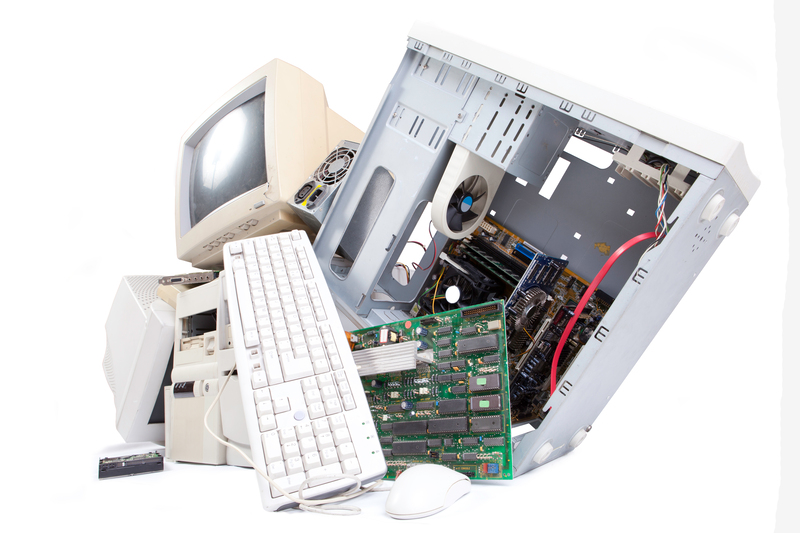Eco-Friendly Methods for PPE Waste Disposal You Should Know
In the wake of the COVID-19 pandemic, the use of Personal Protective Equipment (PPE) such as masks, gloves, gowns, and face shields has surged to unprecedented levels. While PPE has played a crucial role in safeguarding public health, it also poses a significant challenge -- environmental pollution. PPE waste disposal presents a serious threat to ecosystems worldwide when not managed correctly. This comprehensive guide explores eco-friendly ways to handle PPE waste, helping individuals and organizations make responsible choices and protect our planet.

Understanding the Urgency of Sustainable PPE Waste Management
Every year, millions of tons of PPE are discarded globally. Most disposable PPE is made from synthetic materials like polypropylene or polyethylene, which are non-biodegradable and can persist in the environment for centuries. When not disposed of properly, these items clog waterways, harm wildlife, and release microplastics, contributing to the already dire issue of plastic pollution.
- Environmental Threats: PPE waste can block storm drains, pollute oceans, and entangle marine animals.
- Health Hazards: Used PPE can harbor pathogens, posing risks to sanitation workers and the public if not handled safely.
- Visual Pollution: Accumulation of discards like masks and gloves create unsightly litter in cities and natural landscapes.
Therefore, adopting eco-friendly PPE waste disposal methods is not just necessary; it is imperative for the health of our planet and future generations.
Common Types of PPE Waste
To develop effective strategies for sustainable PPE waste handling, it's essential to know what types of waste are being generated:
- Masks: Surgical, N95, and cloth masks, often composed of multiple fabric layers and filters.
- Gloves: Made from latex, nitrile, or vinyl.
- Gowns and Aprons: Typically synthetic material, offering splash protection.
- Face Shields and Goggles: Made of hard or soft plastics.
Most of these items are single-use and were initially designed for the healthcare industry. However, their mass use has extended to the general public, making responsible disposal of PPE a civic duty.
Eco-Friendly Methods for PPE Waste Disposal: What You Should Know
1. Segregation and Safe Collection
Proper segregation is the first step in implementing green PPE waste disposal solutions. PPE waste should be separated from regular household trash to avoid contamination and ensure that it undergoes the right treatment process.
- Dedicated Bins: Use clearly marked containers for used PPE in households, workplaces, and public areas.
- Seal and Secure: Place PPE waste in sealed bags to prevent accidental exposure before final disposal or processing.
- Hand Hygiene: Always wash hands after handling any PPE waste to protect yourself and others.
This organized collection is the foundation of any sustainable PPE waste management plan.
2. Chemical Disinfection and Autoclaving
Once segregated, disinfection and sterilization are vital for ensuring safety and reducing the biohazard risks posed by used PPE.
- Chemical Disinfection: Treating PPE waste with approved solutions (such as sodium hypochlorite) neutralizes pathogens, making the material safer to process further.
- Autoclaving: High-pressure steam treatments can sterilize PPE, especially useful in hospital or laboratory settings, allowing for possible material recycling.
These steps are eco-friendly if the chemicals and energy used are managed efficiently.
3. Mechanical Recycling of PPE Materials
A major development in recent years is the emergence of methods for recycling PPE waste. Since non-woven plastics are the main component, they can be processed and repurposed.
- Sorting and Shredding: After disinfection, masks and gloves can be shredded into flakes.
- Melting and Remolding: The flakes are melted and molded into new products such as construction materials, benches, or pavement blocks.
Several organizations worldwide are pioneering upcycling and recycling projects for PPE, transforming waste into valuable resources and reducing the demand for virgin plastic.
4. Energy Recovery Through Incineration
While incineration is often criticized for its environmental impact, modern techniques with energy recovery and advanced emission controls can be a sustainable option.
- Waste-to-Energy Plants: These facilities can convert PPE waste into electricity or heat, capturing toxic byproducts and minimizing air pollution.
- Compliance with Emission Standards: Assure incineration facilities follow regulations to prevent the release of harmful gases and particulates.
When done with appropriate safeguards, incineration is especially useful for high-risk medical PPE that cannot be recycled.
5. Advanced Biodegradation Technologies
Research is advancing towards enzymatic and microbial degradation of plastics, including PPE. Enzyme-based solutions are being tested to break down complex polymers faster and with less energy compared to traditional methods.
- Enzyme Treatments: Scientists are engineering enzymes specifically designed to degrade polypropylene, the main component in masks and gowns.
- Bioreactors: Controlled environments optimize conditions for bacteria or fungi to digest PPE waste safely and efficiently.
Although still in the early stages, these methods promise to revolutionize environmental PPE waste management in the coming years.
6. Reusable PPE and Circular Economy Approaches
Prevention is better than cure. The adoption of reusable PPE where feasible reduces the overall volume of waste generated.
- Washable Masks and Gowns: Made from high-quality textiles, these can be sanitized and reused multiple times, cutting down on single-use plastic PPE waste.
- Circular Economy Initiatives: Collect, clean, and recirculate PPE within closed-loop systems, especially in healthcare settings.
By shifting towards reusable and recyclable alternatives, individuals and organizations can significantly decrease their environmental footprint.
Key Tips for Individuals on Eco-Friendly PPE Waste Disposal
Not just institutions, but ordinary people can play a vital role in safe and environmentally sound disposal of everyday PPE. Here are actionable steps:
- Don't Litter: Always place used PPE in appropriate disposal bins -- never throw them on the street or in nature.
- Cut Straps: Snip ear loops before disposal to prevent wildlife from getting entangled.
- Participate in Recycling Programs: Seek out local initiatives that collect and recycle used masks and gloves.
- Educate Your Community: Raising awareness about eco-responsible PPE waste disposal can inspire collective action.
- Switch to Reusable Options: When possible and safe, opt for cloth masks and washable PPE.
These simple habits, when adopted by millions, can make a substantial impact.
Government and Industry's Role in Green PPE Waste Solutions
While public behavior is crucial, the biggest strides in eco-friendly PPE disposal stem from policy changes and industry innovation:
- Extended Producer Responsibility (EPR): Manufacturers can be made accountable for post-consumer PPE waste, encouraging design innovations for recyclability and sustainability.
- Setting Up Infrastructure: Governments should invest in dedicated PPE waste collection and processing systems, both in cities and rural areas.
- Research & Development: Funding breakthroughs in biodegradable PPE materials and advanced recycling methods will help mainstream sustainable practices.
- Public Awareness Campaigns: Information drives on eco-conscious PPE waste disposal fuel behavioral change at all levels.
A multi-stakeholder approach involving citizens, industries, and policymakers is essential for systemic change.
Innovative Examples From Around the World
Several countries and businesses are pioneering greener ways to handle PPE waste. Some inspiring case studies include:
- India's Road-Building Initiative: Shredded and sanitized masks and gloves are being mixed into asphalt for durable, eco-friendly roads.
- UK's PPE-to-Furniture Program: Hospitals collect PPE, which is recycled into park benches and picnic tables.
- Australia's PPE Recycling Schemes: Partnerships between clinics and recyclers convert used PPE into products like storage containers and flower pots.
- Global Research on Biodegradable PPE: Universities are developing plant-based biodegradable masks and gloves that decompose naturally.
These innovative projects demonstrate that eco-friendly PPE waste disposal solutions are both possible and practical.
Barriers to Effective Sustainable PPE Waste Management
Despite progress, some challenges remain in widespread adoption of green PPE disposal:
- Hygiene Concerns: Fear of contamination prevents the reuse or recycling of some PPE items.
- Lack of Infrastructure: Many communities lack effective collection and treatment systems for PPE waste.
- Costs: Advanced recycling and biodegradable PPE may be more expensive upfront than traditional options.
- Public Awareness Gaps: Many people are unaware of the environmental impact or alternatives to single-use PPE.
Tackling these obstacles requires focused policy, robust investment, and ongoing education.

The Future of PPE Waste Disposal: Towards a Greener Tomorrow
As the demand for PPE continues, the urgency to adopt eco-friendly PPE disposal practices will only grow. Emerging technologies, growing public awareness, and global collaborations are pointing towards a more sustainable future.
- Biosafe Biodegradable PPE: Ongoing innovation is creating items that naturally break down after use -- the ultimate eco-friendly solution.
- Smarter Collection Systems: AI and IoT will help optimize waste collection and improve segregation at source.
- Recycling Incentives: Schemes that reward individuals and organizations for responsible PPE waste management will drive larger participation.
With collective effort, it's possible to protect both human health and the health of the planet through smarter, sustainable PPE waste disposal.
Conclusion: Your Role in Eco-Friendly PPE Waste Disposal
Sustainable disposal of PPE waste is not just the responsibility of healthcare workers or government agencies; it is a duty shared by every individual. By understanding and utilizing eco-friendly PPE waste solutions, you can help curb pollution, safeguard wildlife, and contribute to a greener, healthier planet.
- Segregate and safely collect PPE waste at home and work
- Disinfect or sterilize before disposal
- Participate in or advocate for recycling programs
- Switch to reusables wherever possible
- Spread awareness about sustainable PPE disposal
Remember, every responsible action counts. Start today -- make eco-friendly PPE waste disposal a daily practice and lead the way towards a sustainable future!